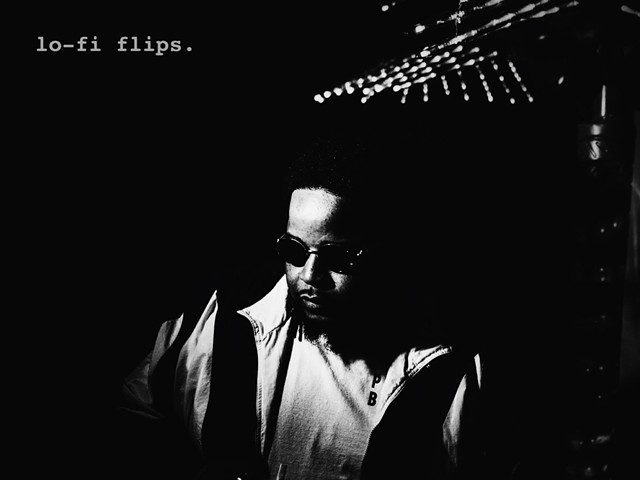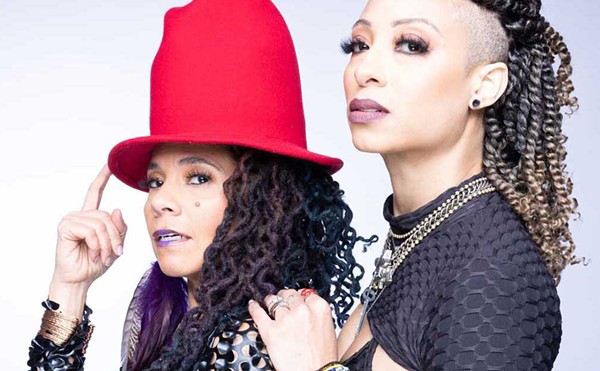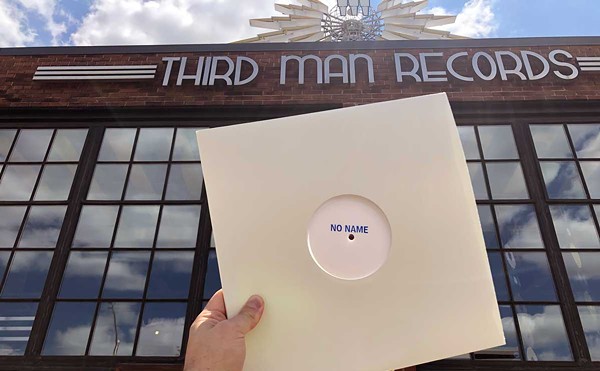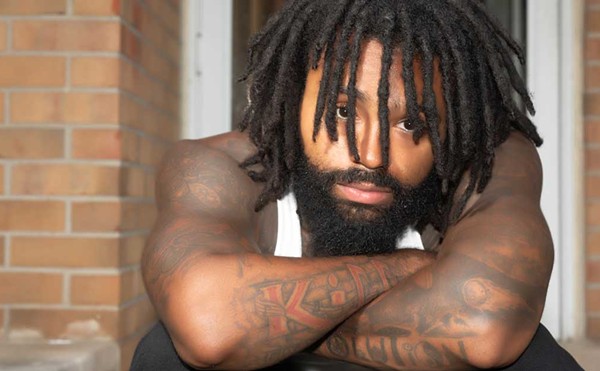These days, legendary soul guitarist and Motown studio musician/Funk Brother Dennis Coffey plays Northern Lights Lounge every Tuesday. But back in 1968, Baker's was the name of the game — and we're not talking about the Keyboard Lounge. This Baker's is Morey Baker's Showplace Lounge, the setting for Coffey's latest: the previously unreleased live album Hot Coffey in the D: Burnin' at Morey Baker's Showplace Lounge (Resonance), featuring fellow local legends organist Lyman Woodard and drummer Melvin Davis.
Coffey and Mike Theodore, his partner in record production — they met working for Golden World Studios in the '60s and among their many credits is Detroit native Rodriguez's 1970 debut Cold Fact — captured this particular set live on some 4-track tapes on a whim during the Lyman Woodard Trio's two-year residency at Morey Baker's. The tapes ended up on Coffey's basement floor and sat there until a confluence of happenings in recent years allowed them to see the light of day.
Coffey ended up sharing the recordings with music journalist Kevin Goins, who brought independent jazz label Resonance Records into the fold. And the result you can hear today — from tapes that had to be baked to keep the coatings from falling off — is a slice of Detroit music history, capturing not only the guitar virtuosity of Coffey, but also the finely tuned accompaniment on organ and drums by Woodard and Davis.
"The whole key to this thing has always been the music," Coffey says. "At the end of the day, what does the music sound like?" When you listen to the album, you get the chance to hear it for yourself. It's one hell of a funky little burner, showcasing at once both the immense individual talents of all three players but also their ability to play together so well in the jazz-soul style they were perfecting at the time.
The songs are all churning expressions of energy in various intensities, offering takes of '60s pop hits (Burt Bacharach via Dusty Springfield's "The Look of Love") and jazz standards (Herbie Hancock's "Maiden Voyage") as well as two originals — the wailing, distortion-heavy funk of "Fuzz" and the groovy "The Big D." The group is so damn tight it sort of feels like they never left that stage and are still there to this day, playing together in smoldering soulful harmony.
As the deluxe CD is released this week, Metro Times sat down with Coffey to learn a bit more about it, the inspiration behind his musical innovations, and Detroit connections beyond the studio, among other things. This interview took place a few days after this reporter saw Coffey perform one of his weekly Tuesday shows.
Metro Times: Do you recall which guitar you used at the show that was recorded?
Dennis Coffey: The one you saw me playing, a Byrdland, I bought new in 1963. But I have different ones. I played at the Gibson 50th Anniversary of the ES-335 and with Les Paul. After I did all that, Gibson gave me a brand-new 355, based upon what I wanted. If I go out on the road, I'll use that guitar. I've got a Gibson L4 I use for jazz. Those are the three guitars I use now. I still have my Firebird from Motown and 345 from sessions I played in California. The guitars that I use that I've actually played a lot of music with, I still have.
MT: You brought fuzz, delay, and wah pedals to funk and soul. What inspired that?
Coffey: When I was playing with Melvin and Lyman at Morey Baker's, that was the time when psychedelic music was really happening. You had Eric Clapton and Jimi Hendrix using those kinds of pedals, so I got into those because my friend Joe Podorsek had a music store and I had access to all the new stuff. When I was playing at Motown, the Jackson 5 came in, and Michael was a little guy at this time. Their dad saw all the pedals and wanted to know what they were, and so I sent him over to Joe's store, and Joe Jackson bought a bunch of pedals for the Jackson 5. That was the first time I saw him. The last time I saw him, I had to play a whole show with them out in LA with no rehearsal because the guitar player left during rehearsal.
The first pedal I used was a Vox Tone Bender for distortion. I used the Cry Baby wah-wah pedal on "Cloud Nine," which got me the job at Motown, and I used an Echoplex for all the different echo effects you can hear on "Ball of Confusion." We didn't do any overdubs at Motown. As a Funk Brother, we went in there, about 11 of us, we sat down in front of an arrangement, and our job was to read it correctly, maybe add a few licks, and get it done in an hour with no mistakes. I still use the wah-wah, but I've probably gone through about five or six of them. Now I use two Boss pedals for distortion and echo [the Blues Driver and the Delay].
MT: Do you have any memories of the late Lyman Woodard you could share?
Coffey: When I listen to the CD now, it brings back a lot of memories. He was just a fantastic organ player. He did the left-handed bass and had the pedals on the floor. He had a good concept of a fat bass sound. He was just an amazing player.
The Woodard family manufactured furniture and they built most of the art museum in Owosso [the Shiawassee Arts Council Gallery]. They were opening up a new wing and wanted me to come, so I went and spent two nights playing in the art museum looking at the Woodard family tree and all the different family members on the wall. I think Lyman was the fourth one in that legacy.
MT: How did you end up in the music business in the first place?
Coffey: My mom told me I could name every song on the radio when I was 2. My mom's side of the family was musicians, but they lived in the Upper Peninsula, so they didn't do it professionally. I took a few piano lessons and that didn't work so I started guitar when I was 8 or 9. It all connected when I went up to the UP and my cousins were playing acoustic guitars, country, and Western. I saw that, and thought, "Wow, you can actually learn how to play this thing." I hadn't had much luck with it, but from that moment when they showed me a few songs, I was hooked.
I got paid for my first record date when I was 15, on Vic Gallon's "I'm Gone." You can hear me doing two guitar solos. By 16, I was working two nights a week, playing a teen club on Friday nights and weddings on Saturday nights. Then I went into the service, I volunteered for the draft in the 101st Airborne, so I was in for a couple years. The last year, I was down in Fort Jackson, and I was playing with Maurice Williams and actually had a record out under the name Clark Summit when I was probably 19 or 20, still in the Army. It just progressed from there. Once I got out of the Army, during summer break I practiced all day. I still practice all the time. My undergrad at Wayne State was Harmony and Theory, [but] I ended up getting a general studies degree, because they did not recognize guitar with music degrees at that point, and a master's degree in education.
After 25 years full time in the music business, I went to work in the automotive business. I started on the line at GM in 1985 and ended up a manufacturing consultant until 2006.
MT: You are Detroit: Motown and the auto industry.
Coffey: My granddaughter and her husband came up here to visit one time from Charleston, and he's a mechanical engineer, so the two things that I could do to entertain them was take them to the Motown Museum and then over to do the Rouge Plant Tour.
MT: What do you think about the Motown Museum expansion?
Coffey: Because I am a Motown alumni, and so is my wife, she used to work in sales, [we learned about it] last January. They rolled out a presentation [but] we had to keep quiet about it because they were still working some details out.
When they first started that museum, they called me. The museum wasn't even open yet, and I walked through the snake pit, as they called it, Studio A. That door had been shut for probably 25 years. They pulled that door open, and I walked in there, and it was a vacant room. You could feel a vibe in there. It was really strange. I told the curators that no one wants to see an empty room. You have to stage it. You have to put the instruments back in here. I walked them around and [pointed out] where the [musicians were] and what they would use. They looked and found whatever they needed to stage it, and that was the beginning of that.
MT: Can you tell me a bit more about how the recordings for Hot Coffey in the D came about?
Coffey: It was recorded at a place a mile and a half down the street from Baker's Keyboard Lounge, on Livernois between Six and Seven Mile, that was called Morey Baker's Showplace Lounge. It goes by the name the Locker Room now. I was working with Melvin Davis and Lyman Woodard at a place called the Frolic Show Bar, and we were doing jazz four nights a week. We got to the point where we were there for a year or two and they wouldn't come up with more money so we quit. We auditioned at Morey Baker's one night and the guy hired us.
We were working three nights a week at Morey Baker's, so [one] of those nights, Mike and I hired a sound engineer to come in. Most of those songs, we might have just done one night. It's live, so whatever it is, it is, but it's got a lot of energy. Now I'm trying to create the same kind of environment at Northern Lights Lounge, that same kind of exploratory vibe I had all the way back then.
MT: Tell me about what it meant to create an exploratory vibe back in '68 and what it means now.
Coffey: The thread, if you've got committed players, which I had back then in Melvin and Lyman, and which I have with my band now, with Drew Schultz [on drums] and Phil Whitfield [on organ] ... we never rehearse. With Melvin and Lyman we never rehearsed. I had chord sheets and I'd count it off and we'd go. If you listen to different takes of the same song in one night, the commonality is sometimes just the melody. After that, the approach is different. Every time we play a song, we put a different spin a on it. You won't hear us play two songs the same way.
Hot Coffey in the D: Burnin' at Morey Baker's Showplace Lounge (Resonance), featuring an extensive 60-page book of liner notes with archival photos and essays, is released this week.
See Dennis Coffey perform with his current band and a rotating cast of singers every Tuesday night at Northern Lights Lounge.





